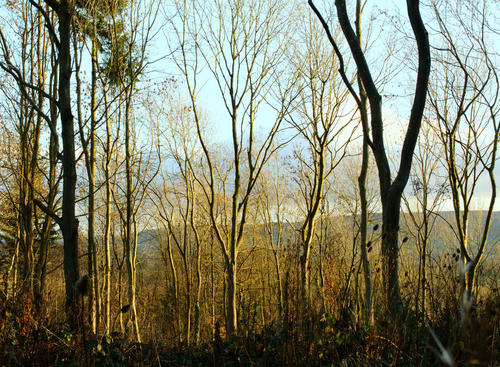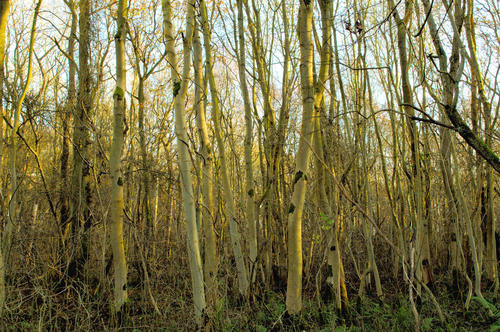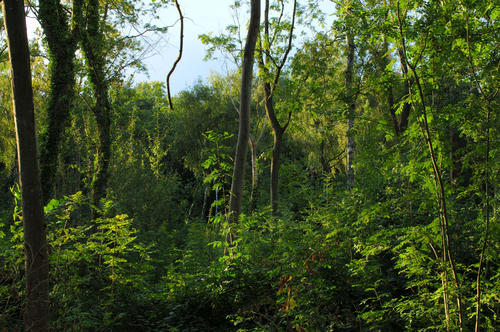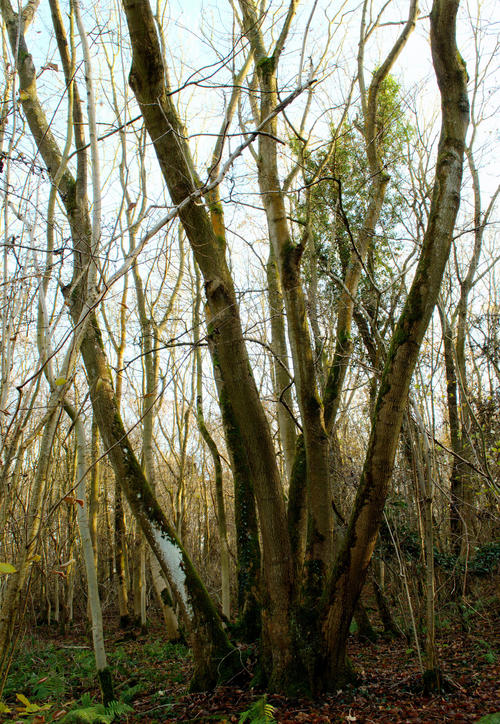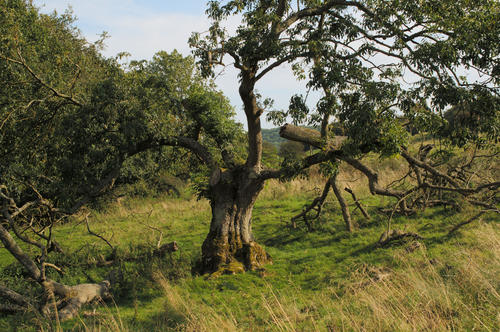Ash dieback caused by the fungus Hymenoscyphus pseudoalbidus (Helotiales: Helotiaceae)(Chalara fraxinea): up to 90% of ash trees Fraxinus excelsior expected to die, and prospects for Tiddesley Wood, Pershore
David M. Green davidmxgreen@gmail.com
Up to 90% of ash trees Fraxinus excelsior in Britain are expected to die within the next 10 years from the pathogenic fungus Hymenoscyphus pseudoalbidus which causes the chronic disease "ash dieback" (not to be confused with the previously known "die back" of the crown of ash trees from physical conditions). There are now almost 300 confirmed cases at separate sites of infected trees, the majority found in mature woodland (Department for Environment, Food and Rural Affairs (Defra) as reported in http://www.bbc.co.uk/news/science-environment-20626053 6th December 2012).
Hymenoscyphus pseudoalbidus - Chalara fraxinea is the asexual (anamorphic) stage of the same species - was ravaging ash Fraxinus excelsior in Poland in 1992, thereafter various parts of Europe. The first record in Britain was February 2012 when it was found in a consignment of infected trees sent from a nursery in the Netherlands to a nursery in Buckinghamshire, England. (http://www.forestry.gov.uk/chalara 2012-Nov-06).
Observing in Denmark that ash plants were dying in nurseries, in 2009 Britain's Horticultural Trades Association proposed to Defra that imports of ash plants to the UK should be banned. But the Forestry Commission of the UK considered the disease was a fungus already endemic to the UK, namely Hymenoscyphus albidus which is not pathogenic, but it was supposed environmental conditions led it to be damaging. (http://www.guardian.co.uk/environment/2012/oct/29/government-ignored-ash-dieback-warnings 6th November 2012). So at that time the pathogen was not correctly identified. Basic knowledge was developing. The following quote from the Wikipedia article Hymenoscyphus pseudoalbidus seems to surmise the taxonomic background conveniently (http://en.wikipedia.org/wiki/Hymenoscyphus_pseudoalbidus 2012-Nov-06):
"The fungus Hymenoscyphus pseudoalbidus was first identified and described in 2006 under the name Chalara fraxinea. [5] In 2009, based on morphological and DNA sequence comparisons, Chalara fraxinea was suggested to be the asexual stage (anamorph) of the ascomycete fungus Hymenoscyphus albidus.[5] However, Hymenoscyphus albidus has been known from Europe since 1851 and is not regarded as pathogenic.[6] In 2010, using molecular genetic methods, the sexual stage (teleomorph) of the fungus was recognized as a new species and named Hymenoscyphus pseudoalbidus.[5] Although Hymenoscyphus pseudoalbidus is said to be "morphologically virtually identical" to Hymenoscyphus albidus, there are substantial genetic differences between the two species.[7]
"The fungus grows during summer on ash petioles in the litter.[6] The ascospores are produced in asci and are transmitted by wind; this might explain the rapid spread of the fungus.[6] It is not known why it has emerged or become so aggressive.[8] but researchers are investigating the theory that the fungus originated in Asia, where ash trees are immune to the disease".
However, there is the argument that it was wrong for to allow continuing import of plants into the UK from areas of Europe where a disease was newly ravaging ash, as knowledge of the pathogen should not have been assumed satisfactory enough to conclude the pathogen was already endemic to Britain where ash was not being ravaged. Spores of the fungus are wind-spread; but import into Britain of spore carrying material hastens or increases the odds of transmission.
Wildlife network failure
It is unsatisfactory that despite a new disease of ash was evidently ravaging parts of Europe nothing significant was communicated generally within Britain so numerous relevant people seem never to have heard of it until recently. The network of conservation organisations in the UK or organisational structure failed to communicate or take note of this threat so nature reserves were managed with the assumption ash trees would continue. Now we face the prospect of woodland reserves containing about 50% ash, such as Tiddesley Wood, near Pershore, that have been managed accordingly, are set to lose up to 40% of their trees. The woodland management was designed for certain conditions which will become different. Ash is particularly important on Bredon Hill where work is done to retain old ash trees. The rare violet click beetle Limoniscus violaceus (Coleoptera: Elateridae) breeds in old ash trees. These sites are only two local examples. Obviously knowledge of events in continental Europe indicating what was likely or might happen in the UK should have been discussed & communicated widely. Other tree diseases & pests are threatening, but this disease of ash is especially obviously virulent, the consequences to woods & landscape changes of the countryside especially consequential. Even if many trees ultimately fail to die, the prospect cannot be ignored. The devastating Dutch elm disease of the elm Ulmus showed what might suddenly happen to a tree species in the UK.
Images
Fig. 01. Tiddesley Wood, south end, looking south: the compartment has been recently felled leaving ash as almost the only trees, so this compartment may be rendered almost treeless (except for coppice growth). 3rd December 2012. David M. Green
Fig. 02. North-east Tiddesley Wood: dense ash, trunks appearing pale in photograph. This is a compartment with trees too dense too grow at the normal rate. The fungus might be expected to thin them out considerably if not eliminating them. 3rd December 2012. David M. Green
Fig. 03. Tiddesley Wood, middle, looking west of main ride: a mixture of oak, ash & silver birch over a vigorous coppice growth much of ash. The ash coppice might be expected to die first, then the remaining ash in following years. The canopy is already very open. The lack of competition of ash coppice might be expected to favour maximum rate of growth for the oaks thereafter. 18th September. David M. Green
Fig. 04. North-east Tiddesley Wood: an example of one of the many approximately 50-60 year old ash grown from coppice from when most of the wood was clear felled or killed with herbicide in the 1950-1960s. 3rd December 2012. David M. Green
Fig. 05. Bredon Hill: near Doctors Wood, Little Comberton: an ash with branches lopped to prolong its life. Will the higher altitude mean Bredon Hill stays above the disease for some years? Older trees are more resistant to the disease, tend more to being chronically affected than saplings that die fast. 15th September 2012. David M. Green
